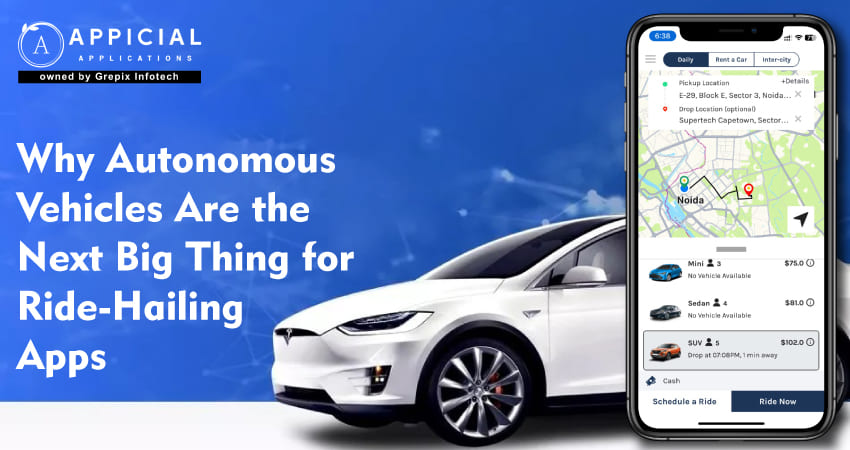
Why Autonomous Vehicles Are the Next Big Thing for Ride-Hailing Apps
In the ever-evolving landscape of transportation, two revolutionary technologies stand out: autonomous vehicles (AVs) and ride-hailing apps. Over the past decade, ride-hailing services like Uber and Lyft have transformed how we navigate cities, offering convenience and flexibility at the tap of a screen. Simultaneously, advancements in autonomous vehicle technology promise to redefine mobility by removing the need for human drivers. When combined, these innovations herald a new era in transportation. This blog explores why autonomous vehicles are poised to become the next big thing for ride-hailing apps and how this convergence will reshape the future of urban mobility.
The future of urban mobility is being reshaped by the convergence of autonomous vehicles (AVs) and ride-hailing apps, promising revolutionary changes in how we navigate cities. Autonomous vehicles, equipped with advanced AI and sensor technology, are progressing towards full autonomy, aiming to enhance safety, reduce operational costs, and increase efficiency. Ride-hailing apps have already transformed personal transportation by offering convenient, real-time services, but face challenges like driver shortages and regulatory hurdles. Together, AVs and ride-hailing represent a transformative force, poised to improve service consistency, reduce traffic congestion, and provide economical transportation solutions while addressing environmental concerns with potential reductions in emissions. This shift towards autonomous ride-hailing could lead to a more sustainable, efficient, and safe urban mobility landscape, fundamentally altering our relationship with daily transportation.
The Rise of Autonomous Vehicles
Autonomous vehicles, often referred to as self-driving cars, are vehicles equipped with advanced sensors, cameras, and artificial intelligence systems that allow them to navigate without human intervention. Companies like Tesla, Waymo, and Cruise have invested billions into developing AV technology, making significant strides toward fully autonomous driving. As of 2023, many vehicles offer Level 2 autonomy partial automation with driver assistance features while prototypes of Level 4 and Level 5 vehicles, capable of full autonomy, are tested on public roads.
The progression of AV technology is driven by a combination of factors: advancements in machine learning algorithms, improvements in sensor technology, and a growing demand for safer, more efficient transportation solutions. Governments worldwide are also recognizing the potential benefits of AVs, implementing regulatory frameworks to facilitate testing and deployment while ensuring safety standards are met.
The Evolution of Ride-Hailing Apps
Ride-hailing apps have revolutionized personal transportation by leveraging smartphone technology to connect passengers with drivers seamlessly. Uber, Lyft, and Didi Chuxing have disrupted traditional taxi industries, offering users convenience, real-time tracking, and competitive pricing. These platforms have not only changed how people move but have also created gig economy opportunities for millions of drivers worldwide.
However, the ride-hailing industry faces several challenges. Driver shortages, fluctuating pricing models, regulatory hurdles, and concerns over passenger safety have highlighted limitations within the current system. The reliance on human drivers introduces variability in service quality and operational costs, prompting companies to explore innovative solutions to enhance efficiency and profitability.
Why Autonomous Vehicles Are a Game Changer for Ride-Hailing
1 Cost Reduction
One of the most significant advantages of integrating autonomous vehicles into ride-hailing services is the potential for substantial cost savings. Human drivers account for a large portion of ride-hailing companies' operational expenses, including wages, benefits, and insurance. By deploying AVs, companies can eliminate these costs, allowing for more competitive pricing and higher profit margins. Passengers could enjoy lower fares, making ride-hailing services more accessible and appealing compared to private car ownership or public transportation.
2 Safety Improvements
Human error is a leading cause of traffic accidents globally. Autonomous vehicles have the potential to significantly reduce accidents by eliminating factors such as distracted driving, fatigue, and impaired driving. Equipped with advanced sensors and real-time data processing capabilities, AVs can react to road conditions faster than human drivers, adhering strictly to traffic laws and optimizing for safety. For ride-hailing services, this enhancement in safety could lead to lower insurance costs and increased passenger trust.
3Increased Efficiency and Availability
Autonomous vehicles can operate around the clock without the need for breaks, increasing the availability of ride-hailing services. This 24/7 operational capability ensures meeting demand at all times, reducing wait times for passengers. Additionally, AVs can be centrally managed and dispatched more efficiently, optimizing routes based on real-time traffic data and demand patterns. This level of efficiency can lead to reduced congestion and improved traffic flow in urban areas.
4 Enhanced Customer Experience
Consistency in service quality is a challenge with human drivers due to varying levels of professionalism and driving skills. Autonomous vehicles offer a standardized experience, ensuring that each ride meets predefined service standards. Passengers can expect clean vehicles, consistent routes, and predictable ride durations. Furthermore, AVs can be customized to offer personalized in-car experiences, such as entertainment options, workspaces, or relaxation settings, enhancing customer satisfaction.
5 Scalability and Growth Opportunities
Deploying autonomous vehicles allows ride-hailing companies to scale their operations rapidly without the constraints associated with recruiting and training drivers. Fleet sizes can be increased in response to market demand, and vehicles can be reallocated dynamically to different areas or services (e.g., ride-sharing, delivery) as needed. This scalability opens new revenue streams and market opportunities, positioning companies to dominate the evolving mobility landscape.Also Read: Carpooling vs. Solo Rides: The Environmental Impact of Your Commute
Economic and Environmental Benefits
1 Lower Emissions with Electric AVs
Many autonomous vehicles are being developed as electric vehicles (EVs), contributing to environmental sustainability goals. The integration of electric AVs into ride-hailing fleets can lead to significant reductions in greenhouse gas emissions and air pollution in urban areas. This shift supports global efforts to combat climate change and aligns with increasing consumer preferences for environmentally friendly transportation options.
2 Reduced Congestion
Autonomous vehicles can communicate with each other and traffic management systems optimize routes and travel speeds, reducing traffic congestion. Efficient routing and platooning where AVs travel closely together at regulated speeds can enhance road capacity and decrease travel times. For cities grappling with congestion issues, the adoption of AVs in ride-hailing services presents a viable solution to improve overall traffic conditions.
3 Economic Benefits for Companies and Users
The cost efficiencies gained from autonomous vehicles can be passed on to consumers in the form of lower fares, making ride-hailing services more competitive with other forms of transportation. For companies, reduced operational costs and increased utilization rates of AVs can lead to higher profitability. Additionally, economies of scale achieved through large AV fleets can further enhance financial performance.
Challenges and Considerations
While the integration of autonomous vehicles into ride-hailing services offers numerous benefits, several challenges must be addressed:
1 Technological Hurdles
Achieving full autonomy requires overcoming complex technological challenges, including perfecting sensor technologies, ensuring reliable software performance in diverse conditions, and safeguarding against cybersecurity threats. Developing AVs that can handle unpredictable scenarios, such as adverse weather or complex urban environments, remains a critical hurdle.
2 Regulatory and Legal Challenges
The deployment of autonomous vehicles involves navigating a complex regulatory landscape. Governments must establish laws and standards for AV operation, liability in the event of accidents, and data privacy concerns. Ride-hailing companies need to work closely with regulators to ensure compliance and promote policies that facilitate AV integration.
3 Public Acceptance and Trust
Gaining public trust in autonomous vehicles is essential for widespread adoption. Concerns over safety, job displacement for drivers, and ethical considerations in programming AV decision-making algorithms need to be addressed transparently. Education and awareness campaigns, along with demonstrable safety records, can help build confidence among consumers.
4 Ethical Considerations
Autonomous vehicles must be programmed to make split-second decisions in scenarios where harm may be unavoidable. Establishing ethical frameworks for these decision-making processes is a complex challenge involving philosophical, legal, and cultural considerations. Ride-hailing companies must engage in ethical discussions and align their AV programming with societal values.
The Future Outlook
The convergence of autonomous vehicles and ride-hailing apps is not a question of if but when. Industry experts predict that by the late 2020s to early 2030s, autonomous ride-hailing services could become mainstream in urban centers. Companies like Waymo and Cruise are already piloting autonomous ride-hailing services in select cities, gathering valuable data and consumer feedback.
Ride-hailing companies must prepare for this transition by investing in AV technology, forming strategic partnerships, and adapting their business models. Integrating AVs requires rethinking fleet management, customer service, and operational strategies. Embracing technologies like artificial intelligence and the Internet of Things (IoT) can enhance vehicle connectivity and performance.
Moreover, the integration of AVs into ride-hailing services can pave the way for innovative mobility solutions, such as on-demand public transit, last-mile connectivity, and mobility-as-a-service (MaaS) platforms. These developments have the potential to transform urban planning, reduce the need for personal vehicle ownership, and create more sustainable and livable cities.
Conclusion
The integration of autonomous vehicles into ride-hailing services represents a transformative shift poised to redefine urban mobility. The convergence of these technologies offers significant benefits, including cost reductions, safety improvements, enhanced customer experiences, and environmental sustainability. While challenges such as technological hurdles, regulatory issues, and public acceptance remain, they are surmountable through innovation, collaboration, and strategic planning.
Appicial Applications is a leading taxi app development company at the forefront of this evolution, offering cutting-edge ride-hailing solutions designed to adapt to the advent of autonomous vehicles. With expertise in developing customizable and scalable ride-hailing apps, Appicial is well-positioned to help businesses navigate the transition toward an autonomous future. By leveraging their advanced technology platforms, companies can seamlessly integrate AVs into their fleets, optimizing operations and staying ahead in the competitive mobility landscape.
Embracing autonomous vehicles is not just a strategic advantage but a necessary progression for ride-hailing companies aiming to lead in the next era of transportation. With partners like Appicial Applications providing the necessary tools and support, businesses can confidently move forward, contributing to a future where urban transportation is safer, more efficient, and environmentally friendly. The journey toward autonomous ride-hailing is underway, and now is the time for industry leaders to drive this change and shape the future of mobility.
Looking out to start your own venture like Uber? Try out our HireMe Taxi Uber Clone, the easiest way to kick-start your taxi business.Author's Bio

Vinay Jain is the Founder at Grepix Infotech and brings over 12 years of entrepreneurial experience. His focus revolves around software & business development and customer satisfaction.
Back to blog list




